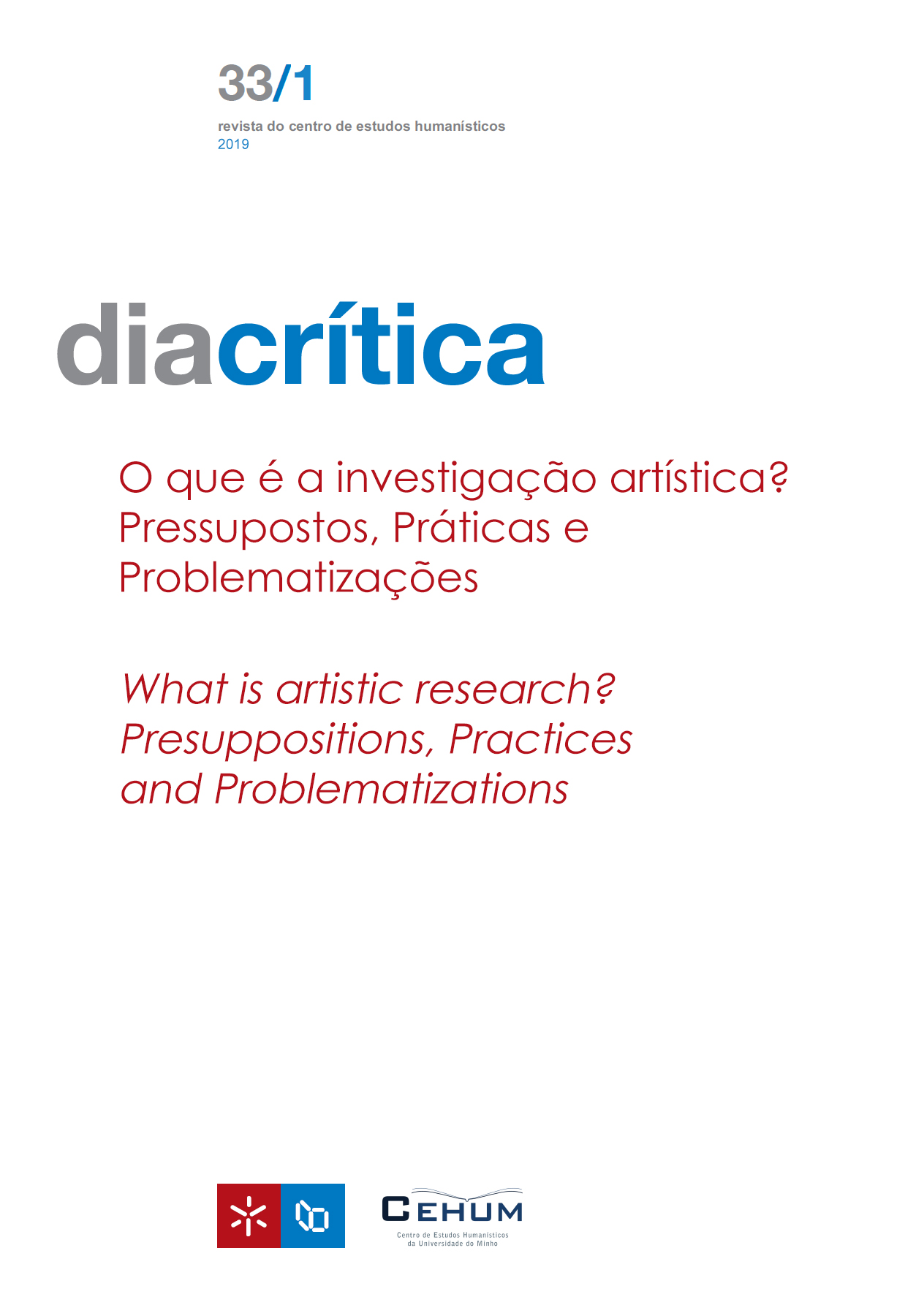The researcher-as-dramaturg: lingering in-between theory and practicer or how artistic strategies enrich academic research. A manifesto to switch gear.
DOI:
https://doi.org/10.21814/diacritica.5044Keywords:
Researcher-as-dramaturg, Intimacy, Sound, Complexidence, Manifest, ListeningAbstract
What does the notion of the dramaturg add to the position of the researcher? In this manifest I explore the position of the researcher-as-dramaturg as an opening up of methodology with strategies from different fields. I propose the researcher-as-dramaturga s a necessary re-evaluation of the process within the realm of academic research.
References
Barton, B. (2018). Wherefore PAR?Discussions on ‘a line of flight’. In A. Arlanderet al.(Eds.), Performance as Research: Knowledge, methods, impact(pp. 1–19) Oxon: Routledge. DOI: https://doi.org/10.4324/9781315157672-1
Candy, L. & Edmonds, E. (2018). Practice-based Research in the creative Arts. Foundations and Futures from the Front Line.Leonardo, 51(1), 63–69. DOI:10;1162LEON_a_01471. DOI: https://doi.org/10.1162/LEON_a_01471
Caravan Productions. Hear.Retrieved Jun. 20, 2019, from <http://www.caravanproduction. be/artists/benjamin-vandewalle/hear>.
Carlyle A. & Lane C. (Eds.)(2013). On Listening.Devon: Uniformbooks.
Danchev, A. (Ed.). (2011). 100 Artists’ Manifestos. London: Penguin Books.
DeLahunta, Scott. (2000). Dance dramaturgy: Speculations and reflections.Dance Journal, 16(1), 20–25.
Edwards, B. (1994). Understanding Architecture Through Drawing.Oxon: Taylor and Francis.
Gallagher, S. & Zahavi, D. (2012). The phenomenological Mind.Oxon: Routledge. DOI: https://doi.org/10.4324/9780203126752
Han, B.-C. (2017). The scent of time: A philosophical essay on the art of lingering.Trad. D. Steuer. Cambridge: Polity Press.
Hansen, P. (2018). Research-based practice: Facilitating transfer across artistic, scholarly ad scientific inquiries. In A. Arlanderet al.(Eds.), Performance as Research: Knowledge, methods, impact(pp. 32–49) Oxon: Routledge. DOI: https://doi.org/10.4324/9781315157672-3
Hansen, P. & Callison D. (2015). Dance dramaturgy.Modes of agency, Awareness and engagement. New York: Palgrave MacMillan. DOI: https://doi.org/10.1057/9781137373229
Hill L. & Paris H. (2014). Performing Proximity. Curious intimacies. Hampshire: Palgrave Macmillan. DOI: https://doi.org/10.1007/978-1-137-32830-4
Ihde, Don (2007). Listening and Voice. Phenomenology of Sound.New York: Suny Press. DOI: https://doi.org/10.1353/book5250
Ingold, T. (2011). Being alive: Essays on movement, knowledge and description. Oxon: Routledge. DOI: https://doi.org/10.4324/9780203818336
Irigaray L. (2017). To be born.Cham: Palgrave Macmillan. DOI: https://doi.org/10.1007/978-3-319-39222-6
Jurriëns, E. (2009). From monologue to dialogue: Radio and reform in Indonesia.Leiden: KITLV Press. DOI: https://doi.org/10.1163/9789004253834
Kasulis, T. P. (2002). Intimacy or integrity: Philosophy and cultural difference.Honolulu: University of Hawaii Press.
Lin, F. L. Y. (2019). Using thematic analysis to facilitate meaning‐making in practice‐led Art and Design research.International Journal of Art & Design Education,38(1), 153–167.DOI: 10.111/jade.12177. DOI: https://doi.org/10.1111/jade.12177
MacCallum, L. (2016). Arts informed research.Mount Saint Vincent University. Retrieved Jun. 20, 2019, from <http://libguides.msv.ca/arts-informed-research>.
Manning, E. (2009). Relationscapes: Movement, art, philosophy.Cambrigde: The MIT Press. DOI: https://doi.org/10.7551/mitpress/9780262134903.001.0001
Musante, K. & DeWalt, B. R. (2002). Participant observation: A guide for fieldworkers.Oxford: AltaMira Press.
Persyn, L. (2018). Field Notes: Hear, a learning process.Leuven [not published].
Persyn, L. (2019). Field Notes: A traveljournal.Berlin [not published].
Solnit, R. (2006). A field guide to getting lost.London: Penguin Books.
Stalpaert, C. (2014).The Distributive Agency of Dramaturgical Labour and the Ethics of Instability: Becoming the outside body, implicated in the life of others.InK. Pewny, J. Callens & J. Coppens (Eds.),Dramaturgies in the new millennium: Relationality, performativity and potentiality,Vol. 44 (pp. 97–110). Tübingen: Gunter Narr Verlag.
Stalpaert, C., de Smet, S., Lievens, B., Persyn, L. & van Baarle, K. (2018). ‘En plots ben ik een individu...’: de fluctuerende functie van dramaturg-als-onderzoeker en onderzoeker-als-dramaturg.Documenta,36(1), 110–121. DOI: https://doi.org/10.21825/doc.v36i1.16449
Van Kerkhoven, M. (1994a). The Theatre is in the City and the City is in the World and Its Walls Are of Skin. State of the Union speech. Retrieved Jan. 18, 2019, from <http://sarma.be/docs/3229>.
Van Kerkhoven, M. (1994b). Kijken zonder potlood in de hand.Theaterschrift5&6On Dramaturgy,SHARMA. Retrieved Jan. 18, 2019, from <http://sarma.be/docs/3108>.
Van Kerkhoven, M. (1999). Van de kleine en de grote dramaturgie.Etcetera jg 17(68), 67–69. Retrieved Jan. 18, 2019, from <http://sarma.be/docs/3189>.
Voegelin, S. (2010). Listening to noise and silence: Towards a Philosophy of sound art.New York: Continuum. DOI: https://doi.org/10.5040/9781501382901
Vondeling, J. E. (2000). The manifest professional: Manifestos and modernist legitimation. College Literature, 27(2), 127–145.
Downloads
Published
How to Cite
Issue
Section
License
Copyright (c) 2023 Leonie Persyn

This work is licensed under a Creative Commons Attribution-NonCommercial 4.0 International License.










